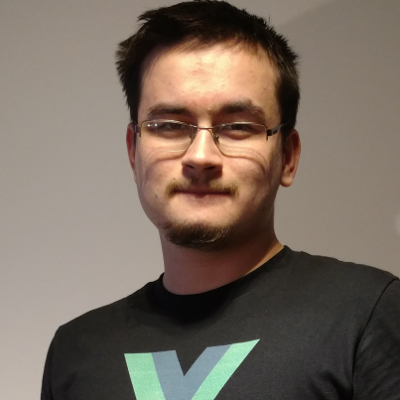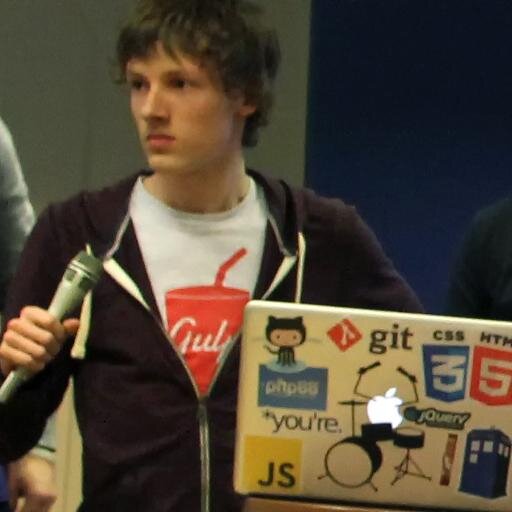Conference program
DAY 2–3 (22–23 June) 9:00 – 18:00
Meet our speakers and discover their awesome talks.
The final schedule will be published once all speakers are announced!

Keynote

Animating Vue
As superfluous as something like animation may initially seem, you can tell a lot about framework by the way that it handles the concept of time. Idiosyncrasies and race conditions in rendering reveal themselves, pauses in DOM and virtual DOM diffing can be exposed. This is one of the ways Vue shows itself to be uniquely capable and elegant as a framework. In this session, we'll cover how to use the <transition> component and some of its offerings to create fluid effects in the browser. We'll move on to watchers and transitioning state. Finally, we'll talk about lifecycle methods, asynchronous updates, and pushing our animations to the next level.

PRA with Vue.js
We will take a look at how Vue.js can work as a PWA (Progressive Web Application). PWA's are boring now, right? Everyone is doing a talk about them, everyone is raving about them. Well let's do something crazy and different! Lets make it realtime. We will take a look at the best patterns when creating an application, and how the Vue.js ecosystem can power a PWA. Extending the PWA platform we will look how Sockets and Service Workers can coexist together. Creating a PRA (Progressive Realtime Application), allowing platforms to improve the user experience without affecting the critical download chain.

No Time to Refactor, How we made the Frontend Awesome At GitLab With Vue.
How we switched from Coffeescript to ES6, from jQuery to Vue, from the asset pipeline to webpack, from static to realtime, all while adding new features, without refactoring and delivering to 1 million+ users and tons of clients.

Code splitting patterns in Vue.js
Vue champions developer experience. It's a bit of Angular on top with React on the bottom. No matter what your preference is, the flexibility baked into the library makes it perfect for anyone. But what about web performance? Can this flexibility still allow us to split code into asynchronous chunks? As a maintainer of webpack, Vue.js was love at first sight for me! Because everything is a Component, everything can also be a Async Component!! This is the ultimate flexibility. Join me while we talk about all the ways to split up your Vue Application. By the time we're done, you'll walk away ready to create high performance Vue Components, Applications, and Libraries.


Server side rendering in Vue.js
Server side rendering offers instant feedback and improves the user experience and SEO. Making Isomorphic application with vue.js might be a daunting task. We are going to see in this talk how Nuxt.js simplify the process to create universal vue application and PWA.

Testing Vue components with Jest
The necessity of testing is still often seen as a burden when writing code, yet when done right, it will dramatically change how code gets written. What makes Vue special in this regards, it’s quite convenient to test for it’s approach in simplicity and leveraged functions and objects wherever possible. In this talk we will look at what makes up a good practice in testing and how jest works. We’ll continue to test some simple Vue Components and see how we can effectively test and store the rendered output with snapshots. Well conclude by looking at a component that heavily relies on Vuex for it’s state management and peek into the possible directions from there.

Make your Apps Realtime with Firebase and Vue
Vue has brought elegant and accessible reactivity to interfaces making it easy to keep the view updated with the local data. On the other hand, Firebase makes it easy to sync the local data with a database, so… what if we combine them to create a super efficient workflow? During this talk, I’ll explain how a real time database like Firebase can make your application even better and why it works so well with Vue. We will understand when and how to integrate Firebase with Vue to create real time applications.

GraphQL made easy with Apollo and Vue
GraphQL is a new way of building client-server interactions that is gaining a lot of traction lately, thanks to the clear advantages it brings to the Web Service world. As an emerging standard, GraphQL needs the community to back the adoption and to create tools so more developers can enjoy it. Apollo is one the most popular GraphQL community project, launched by the Meteor Development Group. The Apollo Client has a very good support of the current spec and features everything you need to use the full power of GraphQL in your apps on multiple platforms. During this talk, we will learn how Apollo can help us start using GraphQL today and how some integrations in our Vue components and Vuex stores will make our lives easier.

Accessibility in Single Page Apps
As developers, we have a responsibility to make sure that as many people as possible can use the websites and applications that we create. But with a new generation of websites—single page applications—come a new set of challenges for users with disabilities, and the assistive technology they use to browse the web. Client-side routing, custom input elements, and shiny animated content: all things that screen readers can struggle with if the developer who implemented it didn't consider accessibility. During this talk, I'll explain what we as developers can do to ensure that our single page applications are usable by everyone, including people who might not use a keyboard, mouse and screen like the majority of us do. I'll show how some assistive technology is used, and demonstrate how some common mistakes we make affect people using that assistive technology.

Best Practices for Hybrid Mobile Apps with Vue.js and Onsen UI
Native apps require specific stacks, which are commonly unknown to web developers, whereas web apps are limited when dealing with native features in mobile devices. On the other hand, hybrid apps combine the power of native and web apps to get the benefits of both sides. It allows creating native-like apps with web technologies such as Vue.js or any other tool that web developers already know and love. Onsen UI is a library of UI components and utilities to help you create beautiful hybrid apps very quickly. Implemented on top of Web Components, Onsen UI is framework agnostic and can easily be combined with Vue.js to bootstrap your apps. It provides a Vue-like API to make its usage very simple and straightforward. Apart from that, Onsen UI’s ecosystem tools manage all jobs related to publishing or updating apps to stores, notifications, device debugging and more.

The Evolution of API Design: From RPC to GraphQL
Over the last 60 years, API designs have changed to respond to everything from new network topologies and new language designs, to the pressures of managing ever larger code bases. Today’s most popular API pattern, REST, was developed in a time where the cost of making API requests were plummeting. At the time, bandwidth was getting cheaper, latency was dropping, and the computing power of devices was still tracking Moore’s Law. Mobile turned this on its head. The environments in which apps and APIs need to perform today have effectively regressed a decade. This talk will explore some of the new client-server interaction models that address today’s pressures and use history to understand the tradeoffs that we made at the transition between the previous designs. I will introduce major tools that are attempting to change the API landscape including GraphQL and Falcor. Since GraphQL is the dominant technology in this space, I will examine some of it’s functionality, touch on some of its syntax and present a live coding demo that shows off a GraphQL server from 0 to 1. Demonstrating a complete implementation in under 10 minutes will give a strong sense of what’s possible, and what kind of complexity burden a tool like this would impose. Spoiler: There is no silver bullet.

Using Serverless Technology to Ship Vue Apps That Scale
'Serverless' is the new flavor of the week in software development, but what does it mean, where did the servers go (spoiler: they're still around!), and how can we leverage this technology to make frontend development easier? In this talk we'll cover the basics of serverless technology, how what we're building at StdLib helps you harness this type of architecture, and ultimately, how you can use this knowledge to ship Vue apps in record time, without configuration and infrastructure management woes.

Avoiding an awkward fit: how to best introduce Vue into your app and team
Vue is versatile. It can be dropped into a page like jQuery, or power an entirely independent frontend. These are the well-known extremes, but for many apps and teams, a lesser-known shade in between would be a better fit. In this talk, we’ll explore the entire spectrum of integration strategies, including varieties at the extremes. For every kind of app, you’ll learn what’s worked for others and what’s held them back, including specific code examples you can adapt for your own apps.